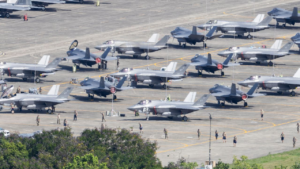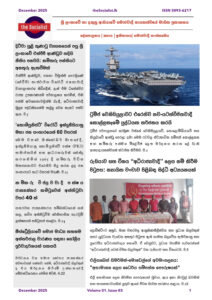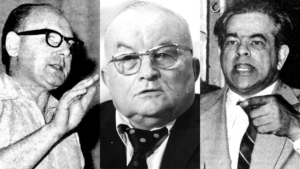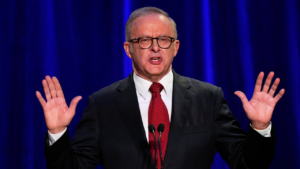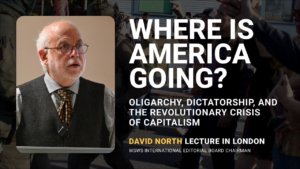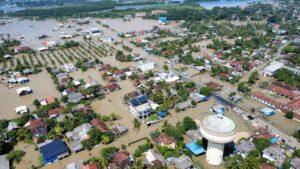By Sanjaya Jayasekera.
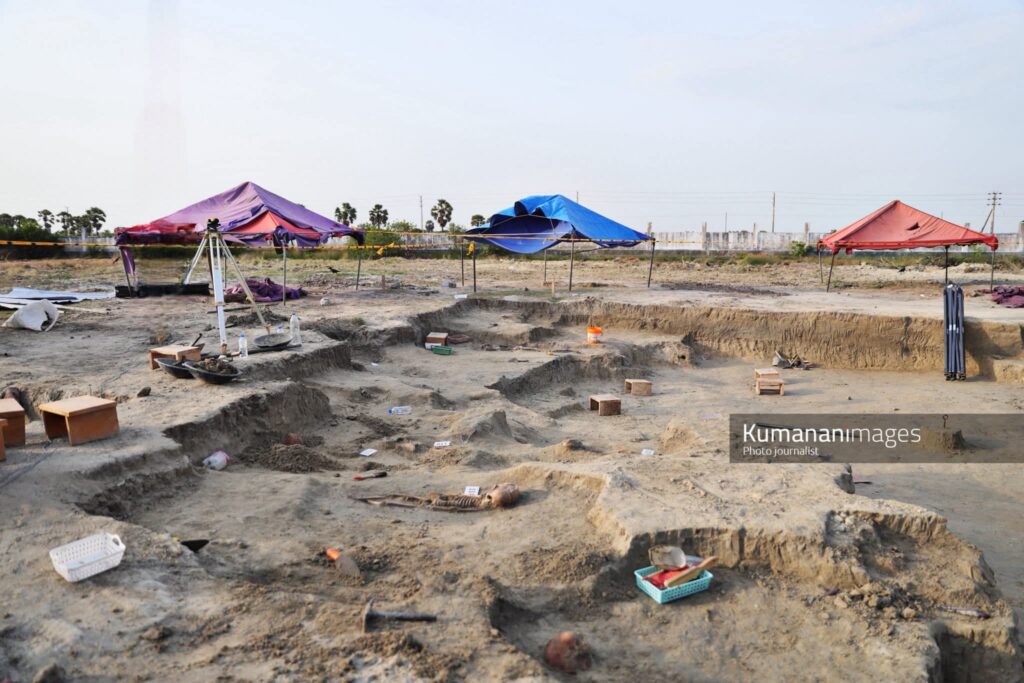
At the close of the 28th day of the second phase of excavations at the newly uncovered Chemmani–Ariyalai “Siththupaththi” Hindu Cemetery mass grave in Jaffna, 147 skeletons have been exhumed—among them toddlers, children, and babies less than twelve months old. The remains were unearthed in a pit as shallow as two feet, scattered without order—some bodies stacked atop one another, some with bent limbs suggesting they were buried alive. All were stripped of clothing, with clear signs of on-the-spot killings of women alongside their babies, hurried burials, and accompanied by chilling artifacts: a school bag identical to those donated by UNESCO in the 1990s, a baby’s toy and a feeding bottle, small glass bangles, socks, slippers, a suspected machine gun barrel, and fractured skulls. These discoveries, together with already available reports and evidence, leave no doubt that these were not the victims of natural disaster or random violence, but of a systematic, state-organised campaign of mass murder.
The ongoing excavation, conducted under the supervision of Jaffna Magistrate A.A. Anandarajah and led by archaeologist Professor Raj Somadeva, was temporarily halted on August 6 and is scheduled to resume on August 22. On August 3 and 4, this writer visited the site and spoke directly with the Magistrate; J. Thathparan, Executive Director of the Office of Missing Persons (OMP); and Professor Somadeva. All confirmed the significance of the discovery—not only for the scale of barbarism and human tragedy it reveals, but also for the irrefutable evidence it provides of crimes committed against innocent civilians.

Chemmani from 1998 to today: Linking State Military to the Graves
One does not have to grope around to relate these mass graves to the Sri Lankan armed forces who occupied Jaffna after 1995. It is an indisputable fact—even acknowledged by ultra-right Sinhala racists—that mass graves exist and massacres were carried out by the state military. Alarmed by the Chemmani exhumations, racist warmonger Udaya Gammanpila, leader of the Pivithuru Hela Urumaya and a former minister, told the media: “The North is war-ravaged, so mass graves will appear anywhere. Digging them up and commenting [on them] is pointless and a waste of money.”
Asian Human Rights Commission (AHRC) reported in December 1997: “The fate of about 600 people who disappeared from Jaffna Peninsula in recent times is unknown”. The name “Chemmani” entered the world’s attention in July 1998, when Sri Lanka Army Corporal Dewage Somaratna Rajapaksha, convicted for the rape and murder of 18-year-old Tamil schoolgirl Krishanthi Kumaraswamy, told the Colombo High Court: “We didn’t kill anyone. We only buried bodies. We can show you where 300 to 400 bodies have been buried.”
In Jaffna Magistrate Court, just prior to exhumations in June 1999, he said, “I can show you how people were arrested in Ariyalai, tortured and buried…I can show you 10 places in Chemmani where bodies are buried. The other four convicted with me can show another six places.”
Rajapaksha’s testimony exposed a network of clandestine mass graves in the Jaffna area, containing hundreds of civilians who had “disappeared” following the Sri Lankan military’s recapture of the peninsula in 1995. In the late 1990s, limited excavations at Chemmani confirmed the remains of 15 individuals, but political obstruction, witness intimidation, procedural impediments, and the deliberate tampering with evidence ensured that most sites remained untouched for over two decades—like many other mass graves scattered across the country.
The present Ariyalai mass grave—only a short distance from the original Chemmani site—confirms the truth of Rajapaksha’s claims and directly links the Sri Lankan army to these atrocities. Media reports from the period documented hundreds of Tamil civilians vanishing after being stopped at military checkpoints and round-ups. The close proximity of the central army camp at Chemmani at the time, few yards away from the burial site, random placement of the skeletons, absence of clothing, a military item found with the bodies, and evidence of blunt force trauma all fit the established pattern of military abductions, torture, and summary executions.
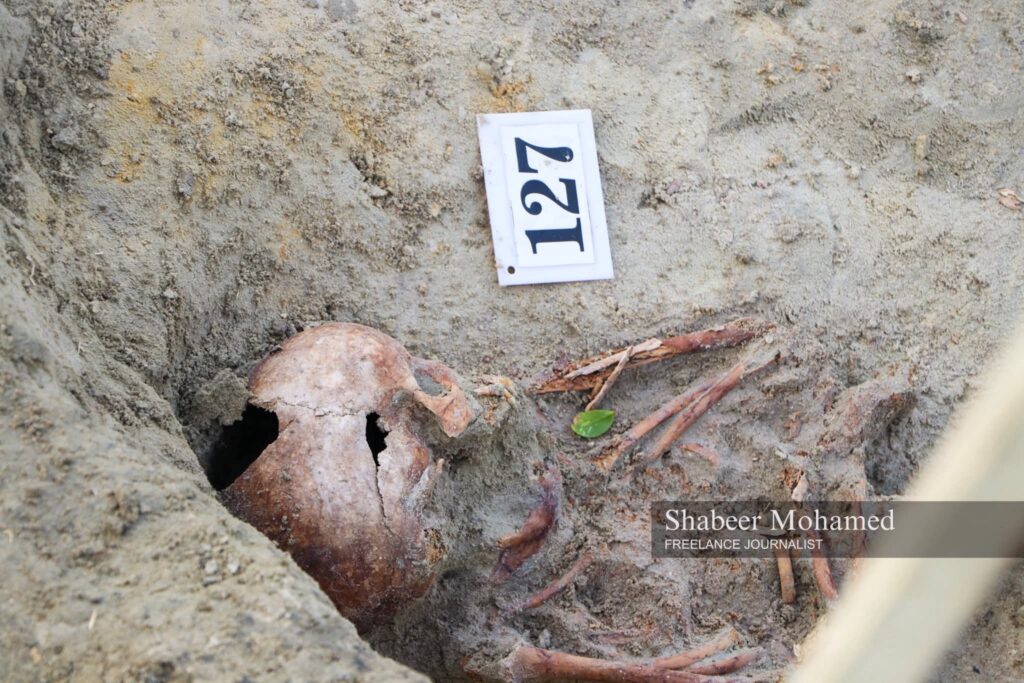
State repression: from the North to the South
The AHRC documented the systematic nature of disappearances, noting in December 1997 that more than 16,700 cases had been verified in the South during the 1988–90 counterinsurgency against the fascist Janatha Vimukthi Peramuna (JVP). Only in isolated instances were prosecutions initiated against the perpetrators, and almost all of these resulted in no convictions. In both the South and the North, the Sri Lankan ruling elite deployed the full apparatus of the state—the military and police, death squads, the Prevention of Terrorism Act, and emergency regulations that served as a legal licence to kill and dispose of bodies with impunity, along with the use of mass graves—to eliminate perceived threats to capitalist rule from the political right and, above all, against the innocent rural poor and the oppressed.
There were, however, differences in the methods of disposal. In the South, tyre pyres—burning corpses in public—were used to terrorise the population and demonstrate the cost of defiance. In the North and East, the army often concealed its crimes, burying the bodies in remote or controlled areas to evade scrutiny while continuing the repression.
These were not “excesses” or “aberrations,” but the outcome of deliberate class policy. The AHRC identified seven patterns behind disappearances, including direct political decisions to eliminate thousands as a precondition for introducing free-market economic policies, and the use of 1965 Indonesian-style mass killings as a model for repression.
Successive governments, shared crimes
The Chemmani mass graves, like nearly two dozen others uncovered around the island, indict not only the military but every government—UNP, SLFP, SLPP, and now NPP/JVP—that has presided over a regime of impunity for state violence.
The Janatha Vimukthi Peramuna (JVP), which today attempts to posture as a “clean” and democratic force, played a key role in the nationalist, chauvinist, and militarist campaigns that legitimised repression in both the North and the South—at least since July 1987, when the reactionary Indo–Sri Lanka Accord was signed. The JVP did so while entering into coalition governments with former presidents Chandrika Kumaratunga and Mahinda Rajapaksa. The JVP’s hands are soaked in the blood of Tamils. Its current silence on Chemmani speaks volumes about its real class allegiance—to the capitalist state and imperialism, which it defends against the working class and the poor.
Militarization, Intimidation, and Suppression
In the South, it was only after 1994—when President Kumaratunga came to power with phony pledges of truth and justice to the families of the disappeared—that limited space was opened for victims of state terror under the UNP government and of JVP fascists to lodge even police complaints. Soon, the military was elevated to the highest esteem by the People’s Alliance (PA) government in resuming the war against the separatist Liberation Tigers of Tamil Eelam (LTTE). The continued militarization and repression in the North did not spare the South, where abductions were commonplace under president Rajapaksa’s reinvigorated war, keeping the working class and all dissenters in a state of terror. All throughout, the JVP waged a sinister chauvinist campaign supporting the war. Today, retired military officers have largely found a safe haven under the JVP/NPP government. These were the conditions that prevented the aggrieved relatives of the disappeared from pursuing judicial processes, while the police and military actively intervened to block prosecutions.
Nationalist traps and the dead-end of appeals to imperialism
Neither Tamil nationalist organisations operating in the North or Colombo, nor the Tamil diaspora—whose real aim is to secure an elite self-rule in the North and East to safeguard their privileges against the Tamil working class and poor—offer any way forward. Their appeals to the United Nations, Western governments, and international human rights bodies have only been pretexts, largely for US imperialism to exert pressure on Colombo into submission. These are the very same imperialist powers that provided military, intelligence, and diplomatic backing to Colombo during the war.
Similarly, Sinhala nationalism justifies past and present massacres under the cover of “protecting the unitary state” and defending “national security.” Both ethnic nationalisms serve to divide the working class, the only social force capable of ending the cycle of repression and impunity.
Massacres as class war
Like the massacres in the South during 1988–90, those in the North and East during the 1983–2009 anti-Tamil civil war were not simply crimes committed against an ethnic minority, but primarily acts of class war. The victims—whether rural Sinhala youth accused of JVP links, or Tamil villagers suspected of aiding the LTTE—were overwhelmingly drawn from the working class, unemployed youth and oppressed rural poor. Their elimination was intended to crush political opposition and terrorise the masses into accepting the “open economy” policies demanded by the local bourgeoisie and international finance capital.
As the International Committee of the Fourth International (ICFI) has emphatically explained, there has been—and will be—no justice for the victims of the South without justice for the victims of the North, and vice versa. The capitalist state, founded in 1948 on communal division, cannot and will not prosecute itself.
The way forward: a socialist programme for the working class and the Oppressed
The ICFI advances a clear perspective for ending repression and securing genuine justice: the independent political mobilisation of the working class, uniting Sinhala, Tamil, and Muslim workers in the struggle for a Sri Lanka–Eelam United Socialist States, as part of the Union of Socialist Republics of South Asia.
This requires building a revolutionary party grounded in the Trotskyist programme of permanent revolution, fighting to unite the oppressed rural and urban poor, along with unemployed youth, behind the leadership of the working class. The middle class and petty bourgeoisie must break from nationalist illusions and join forces with their true class brothers and sisters, both nationally and internationally.
The truth is that justice will not come from The Hague, Geneva, or Washington, but from the victory of the working class over the capitalist system that breeds war, dictatorship, and mass murder. The graves at Chemmani are not merely relics of past atrocities—they are a warning of what the Sri Lankan state will resort to again if the working class suffers another defeat. This is not a distant possibility but a living reality, demonstrated before our eyes in the ongoing genocide of the Palestinians by imperialist-backed Zionist Israel.

